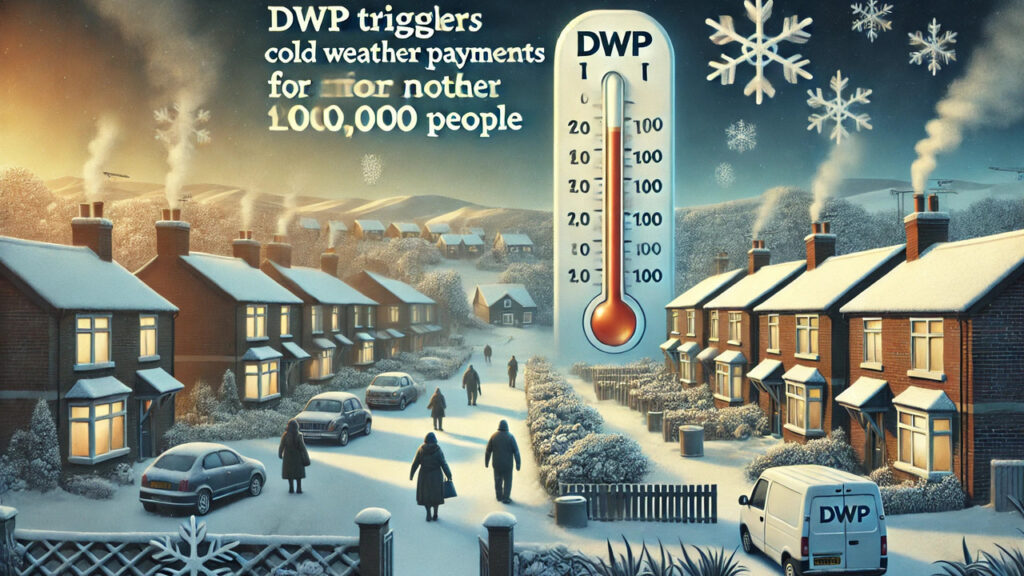As winter tightens its grip on the UK, the Department for Work and Pensions DWP Triggers Cold Weather Payments for Another 200000 People. This vital financial support is designed to help vulnerable individuals and families cope with the increased heating costs that come with severe cold weather. In this article, we will explore the impact of these payments, the eligibility criteria, and the significance of this timely intervention by the DWP.
What is the Cold Weather Payment?
The Cold Weather Payment is a government initiative aimed at providing financial relief to those who are most at risk during the winter months. When temperatures in a specific area drop to or below 0°C for seven consecutive days, eligible households receive a payment of £25 for each qualifying week of cold weather. This payment is crucial for those who are on low incomes, particularly the elderly, disabled individuals, and families with young children, who may struggle to afford the higher energy bills that come with keeping their homes warm during winter.
The Impact of Cold Weather Payments
The activation of Cold Weather Payments for another 200,000 people underscores the increasing need for financial support during the coldest months of the year. As energy prices continue to rise, many households face the daunting challenge of balancing their budgets while ensuring they can keep their homes warm. The Cold Weather Payment helps to alleviate some of this financial burden, ensuring that vulnerable populations can maintain a safe and comfortable living environment.
For many recipients, this payment can mean the difference between enduring the cold and staying warm. The health implications of cold weather are significant, particularly for the elderly and those with pre-existing health conditions. Exposure to freezing temperatures can lead to a range of health issues, including hypothermia, respiratory infections, and increased risk of heart attacks. By providing financial assistance to those who need it most, the DWP’s Cold Weather Payments play a critical role in safeguarding the health and well-being of vulnerable individuals.
Eligibility Criteria for Cold Weather Payments
To qualify for the Cold Weather Payment, individuals must be receiving one of the following benefits:
- Pension Credit: This benefit is available to individuals of pension age who are on a low income.
- Income Support: Available to individuals on a low income, including those who are pregnant or caring for a child under five.
- Income-based Jobseeker’s Jobseeker’s Allowance (JSA): For individuals who are unemployed and on a low income.
- Income-related Employment and Support Allowance (ESA): For those who are ill or disabled and on a low income.
- Universal Credit: Individuals receiving Universal Credit may qualify for Cold Weather Payments if they are not employed or self-employed, and one of the following applies: they have a health condition or disability, they have a child under five living with them, or they have a disabled child in the household.
- Support for Mortgage Interest (SMI): This benefit helps with mortgage interest payments for those on a low income.
The eligibility for Cold Weather Payments is automatically determined based on the receipt of these benefits. If you qualify, you do not need to apply separately. The payment is made automatically and entered into your bank account.
The Process of Triggering Cold Weather Payments
Cold Weather Payments are triggered by data from the Met Office and are based on local temperatures. When the temperature in a specific area falls to 0°C or below for seven consecutive days, the payment is automatically issued. The DWP works closely with the Met Office to monitor weather conditions across the UK, ensuring that payments are made promptly to those who are eligible.
Conclusion
The DWP Triggers Cold Weather Payments for Another 200000 People is a timely and necessary response to the challenges posed by winter’s harsh conditions. As energy costs continue to rise, these payments provide crucial financial support to those who are most vulnerable, helping to ensure they can keep their homes warm and safe.
For those who are eligible, the Cold Weather Payment is more than just financial assistance—it is a lifeline during the coldest months of the year. As temperatures drop, it is essential for individuals to be aware of their eligibility and to ensure they receive the support they are entitled to.
FAQs
1. Who qualifies for the Cold Weather Payment?
Individuals receiving specific benefits such as Pension Credit, Income Support, income-based Jobseeker’sJobseeker’s Allowance, income-related Employment and Support Allowance, Universal Credit, or Support for Mortgage Interest may qualify for Cold Weather Payments.
2. How much is the Cold Weather Payment?
Eligible households receive £25 for each seven days of cold weather, defined as temperatures at or below 0°C.
3. Do I need to apply for the Cold Weather Payment?
No, you do not need to apply. If you are eligible, the payment will be made automatically into your bank account.
4. What should I do if I think I am eligible but have yet to receive a payment?
If you believe you are eligible but have yet to receive a payment, contact the Pension Service or Jobcentre Plus to inquire about your situation.
5. How are Cold Weather Payments triggered?
Cold Weather Payments are triggered based on data from the Met Office. If the temperature in your area drops to or below 0°C for seven consecutive days, a payment is automatically issued.
Also Read: What is AV Tub: An In-Depth Exploration
